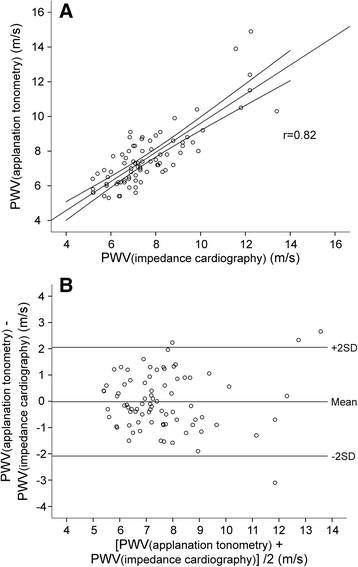Central wave reflection is associated with peripheral arterial resistance in addition to arterial stiffness in subjects without antihypertensive medication
- PMID: 27266507
- PMCID: PMC4897906
- DOI: 10.1186/s12872-016-0303-6
Central wave reflection is associated with peripheral arterial resistance in addition to arterial stiffness in subjects without antihypertensive medication
Abstract
Background: Augmentation index, a marker of central wave reflection, is influenced by age, sex, height, blood pressure, heart rate, and arterial stiffness. However, the detailed haemodynamic determinants of augmentation index, and their relations, remain uncertain. We examined the association of augmentation index with vascular resistance and other haemodynamic and non-haemodynamic factors.
Methods: Background information, laboratory values, and haemodynamics of 488 subjects (239 men, 249 women) without antihypertensive medication were obtained. Indices of central wave reflection, systemic vascular resistance, cardiac function, and pulse wave velocity were measured using continuous radial pulse wave analysis and whole-body impedance cardiography.
Results: In a regression model including only haemodynamic variables, augmentation index in males and female subjects, respectively, was associated with systemic vascular resistance (β = 0.425, β = 0.336), pulse wave velocity (β = 0.409, β = 0.400) (P < 0.001 for all), stroke volume (β = 0.256, β = 0.278) (P = 0.001 for both) and heart rate (β = -0.150, β = -0.156) (P = 0.049 and P = 0.036). When age, height, weight, smoking habits, and laboratory values were included in the regression model, the most significant explanatory variables for augmentation index in males and females, respectively, were age (β = 0.577, β = 0.557) and systemic vascular resistance (β = 0.437, β = 0.295) (P < 0.001 for all). In the final regression model, pulse wave velocity was not a significant explanatory variable for augmentation index, probably due to the high correlation of this variable with age (Spearman's correlation ≥0.617).
Conclusion: Augmentation index is strongly associated with systemic vascular resistance in addition to arterial stiffness.
Trial registration: ClinicalTrials.gov, NCT01742702 .
Keywords: Arterial stiffness; Augmentation index; Central wave reflection; Systemic vascular resistance.
Figures




Similar articles
-
The type of the functional cardiovascular response to upright posture is associated with arterial stiffness: a cross-sectional study in 470 volunteers.BMC Cardiovasc Disord. 2016 May 23;16:101. doi: 10.1186/s12872-016-0281-8. BMC Cardiovasc Disord. 2016. PMID: 27216309 Free PMC article.
-
LDL cholesterol is associated with systemic vascular resistance and wave reflection in subjects naive to cardiovascular drugs.Blood Press. 2019 Feb;28(1):4-14. doi: 10.1080/08037051.2018.1521263. Epub 2018 Oct 29. Blood Press. 2019. PMID: 30369274
-
Doppler indexes of left ventricular systolic and diastolic flow and central pulse pressure in relation to renal resistive index.Am J Hypertens. 2015 Apr;28(4):535-45. doi: 10.1093/ajh/hpu185. Epub 2014 Sep 20. Am J Hypertens. 2015. PMID: 25241047
-
A review of methods to determine the functional arterial parameters stiffness and resistance.J Hypertens. 2013 Sep;31(9):1769-75. doi: 10.1097/HJH.0b013e3283633589. J Hypertens. 2013. PMID: 23777762 Review.
-
Central blood pressure as an index of antihypertensive control: determinants and potential value.Can J Cardiol. 2014 May;30(5 Suppl):S23-8. doi: 10.1016/j.cjca.2014.03.010. Epub 2014 Mar 12. Can J Cardiol. 2014. PMID: 24750979 Review.
Cited by
-
Childhood Obesity: Does it Have Any Effect on Young Arteries?Front Pediatr. 2020 Jul 16;8:389. doi: 10.3389/fped.2020.00389. eCollection 2020. Front Pediatr. 2020. PMID: 32766188 Free PMC article.
-
Differences in heart rate responses to upright posture are associated with variations in the high-frequency power of heart rate variability.Am J Physiol Heart Circ Physiol. 2024 Mar 1;326(3):H479-H489. doi: 10.1152/ajpheart.00567.2023. Epub 2023 Dec 22. Am J Physiol Heart Circ Physiol. 2024. PMID: 38133619 Free PMC article.
-
Impact of aging on cardiovascular dynamics and heart rate variability during passive head-up tilt.Physiol Rep. 2025 Jul;13(14):e70477. doi: 10.14814/phy2.70477. Physiol Rep. 2025. PMID: 40685803 Free PMC article.
-
Liquorice ingestion attenuates vasodilatation via exogenous nitric oxide donor but not via β2-adrenoceptor stimulation.PLoS One. 2019 Oct 18;14(10):e0223654. doi: 10.1371/journal.pone.0223654. eCollection 2019. PLoS One. 2019. PMID: 31626649 Free PMC article.
-
Positive correlation of the serum angiopoietin-like protein 3 levels with the aortic augmentation index in patients with coronary artery disease.Ther Clin Risk Manag. 2018 Feb 5;14:231-236. doi: 10.2147/TCRM.S150476. eCollection 2018. Ther Clin Risk Manag. 2018. PMID: 29440908 Free PMC article.
References
-
- Nichols WW, O’Rourke MF. McDonald’s Blood Flow in Arteries: Theoretical, Experimental and Clinical Principles. London: Arnold; 1998.
-
- Laurent S, Cockcroft J, Van Bortel L, Boutouyrie P, Giannattasio C, Hayoz D, Pannier B, Vlachopoulos C, Wilkinson I, Struijker-Boudier H. Expert consensus document on arterial stiffness: methodological issues and clinical applications. Eur Heart J. 2006;27(21):2588–605. doi: 10.1093/eurheartj/ehl254. - DOI - PubMed
Publication types
MeSH terms
Associated data
LinkOut - more resources
Full Text Sources
Other Literature Sources
Medical

